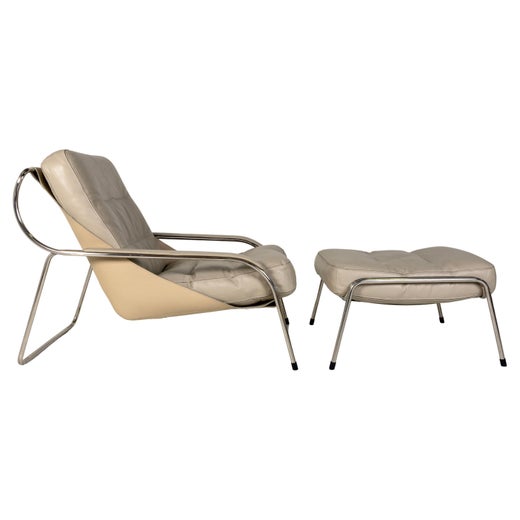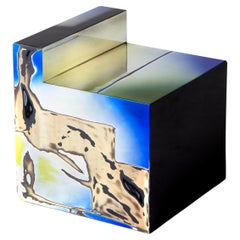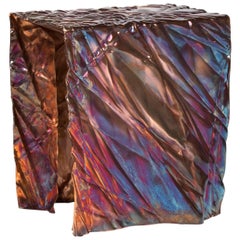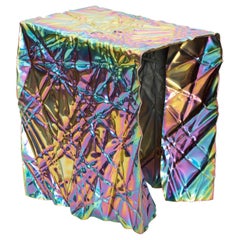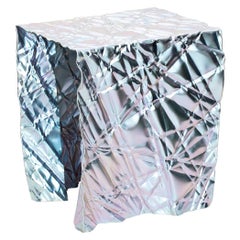Max Bill Ulm Stool
About the Item
- Creator:
- Dimensions:Height: 18 in (45.72 cm)Width: 16 in (40.64 cm)Depth: 11 in (27.94 cm)
- Style:Modern (Of the Period)
- Materials and Techniques:
- Place of Origin:
- Period:
- Date of Manufacture:1970s
- Condition:Wear consistent with age and use.
- Seller Location:Brooklyn, NY
- Reference Number:1stDibs: LU80723100722
Max Bill
Max Bill was born in Winterthur, Switzerland. After an apprenticeship as a silversmith during 1924–27, he took up studies at the Bauhaus in Dessau under many teachers including Wassily Kandinsky, Paul Klee and Oskar Schlemmer from 1927 to 1929, after which he moved to Zurich.
After working on graphic designs for the few modern buildings being constructed, Bill built his first work, his own house and studio (1932–3) in Zurich-Höngg. From 1937 onward he was a prime mover behind the Allianz group of Swiss artists.
Bill is widely considered the single most decisive influence on Swiss graphic design beginning in the 1950s with his theoretical writing and progressive work. His connection to the days of modernism gave him special authority. As an industrial designer, his work is characterized by a clarity of design and precise proportions. Examples are the elegant clocks and watches designed for Junghans, a long-term client. Among Bill's most notable product designs is the Ulmer Hocker of 1954, a stool that can also be used as a shelf element, a speaker's desk, a tablet or a side table. Although the stool was a creation of both Bill's and Ulm School designer Hans Gugelot's, it is often called "Bill Hocker" because the first sketch of it on a cocktail napkin was Bill's work.
As a designer and artist, Bill sought to create forms which visually represent the New Physics of the early 20th century. He sought to create objects so that the new science of form could be understood by the senses: that is as a concrete art. Thus Bill is not a rationalist – as is typically thought – but rather a phenomenologist. He made spare geometric paintings, prints and spherical sculptures, some based on the Möbius strip, in stone, wood, metal and plaster. His architectural work included an office building in Germany, a radio studio in Zurich, and a bridge in eastern Switzerland.
Bill continued to produce architectural designs, such as those for a museum of contemporary art (1981) in Florence and for the Bauhaus Archive (1987) in Berlin. In 1982 he also entered a competition for an addition to the Neue Nationalgalerie in Berlin, built to a design by Ludwig Mies van der Rohe. Pavillon-Skulptur, a large granite sculpture, was installed adjacent to the Bahnhofstrasse, Zürich in 1983. As is often the case with modern art in public places, the installation generated some controversy. Endlose Treppe, a sculpture made of North American granite, was designed for the philosopher Ernst Bloch.
In 1982 he was awarded the Sir Misha Black award and was added to the College of Medallists.
Bill executed many public sculptures in Europe and exhibited extensively in galleries and museums, including a retrospective at the Kunsthaus Zürich in 1968–69. He was the subject of retrospectives at the Albright-Knox Art Gallery in Buffalo and the Los Angeles County Museum of Art in 1974, and the Solomon R. Guggenheim Museum in New York City in 1988.
Find vintage Max Bill stools, lighting, and other furniture on 1stDibs.
Zanotta
Entrepreneur Aurelio Zanotta founded Zanotta in 1954 in Nova Milanese, Italy. Originally called Zanotta Poltrona, it specialized in traditional furniture. By the early 1960s, however, Zanotta had established a reputation for edgy mid-century modern design. Today’s vintage furniture collectors know the brand well for its innovative and wholly sculptural chairs, coffee tables and more.
One of Zanotta’s earliest successes was the Mezzadro stool — better known as the Tractor stool — designed by Pier Giacomo Castiglioni and his brother Achille in the late 1950s. In 1965, Zanotta was among the first furniture companies to work with expanded polyurethane foam and frameless construction, such as for the Throw-Away sofas and armchairs designed by Willie Landels. Another popular design was the Blow chair — designed by Jonathan De Pas, Donato D’Urbino, Paolo Lomazzi and Carla Scolari — viewed by many as a physical expression of late '60s carefree culture.
In 1969, amid the provocative movement we now call Italian Radical Design, Zanotta’s Sacco chair garnered major attention. The boundary-pushing beanbag chair was the brainchild of designers Piero Gatti, Cesare Paolini and Franco Teodoro who presented it to Aurelio Zanotta as a transparent vinyl sack loosely filled with small polystyrene balls. He suggested its signature brightly colored leather.
The Sacco chair won the 1970 ADI Design Museum’s Compasso d’Oro award. In 1972, the Museum of Modern Art in New York included it in the landmark exhibition “Italy: The New Domestic Landscape” curated by designer Emilio Ambasz. In 2020, it received a Compasso d’Oro ADI Lifetime Achievement Award for 50 years of enduring popularity. It is now in museum collections around the world including the Triennale Design Museum of Milan, the Musée des Arts Décoratifs in Paris, and London’s Victoria & Albert Museum.
After Aurelio Zanotta died in 1991, the company remained in his family and has been run by his three children since 2002. Zanotta continues to set the bar high for furniture design with trend-setting pieces.
On 1stDibs, find a collection of vintage Zanotta seating, tables and other furniture.
You May Also Like
Vintage 1950s European Mid-Century Modern Stools
Wood
Vintage 1970s Italian Mid-Century Modern Stools
Birch
Mid-20th Century German Mid-Century Modern Stools
Spruce
21st Century and Contemporary Italian Stools
Birch
21st Century and Contemporary Italian Stools
Birch
Mid-20th Century German Mid-Century Modern Stools
Beech, Spruce
Mid-20th Century German Mid-Century Modern Stools
Beech, Birch
2010s German Mid-Century Modern Stools
Beech, Birch
Mid-20th Century German Mid-Century Modern Stools
Nutwood
21st Century and Contemporary English Regency Benches
Brass
More From This Seller
View All2010s Spanish Stools
Chrome
2010s American Stools
Steel
2010s American Stools
Steel
2010s American Stools
Steel
2010s American Stools
Steel
2010s American Stools
Steel
Recently Viewed
View AllRead More
Photographer to Know: Jeannette Montgomery Barron
Her stunning portraits of Jean-Michel Basquiat, Andy Warhol and other artists chronicle a crucial chapter of New York’s cultural history.
With Zanotta House, an Italian Design Dream Home Lands in New York City
Alessia Genova takes us on a tour of her design for the eminent furniture maker’s new shoppable townhouse in Greenwich Village.

